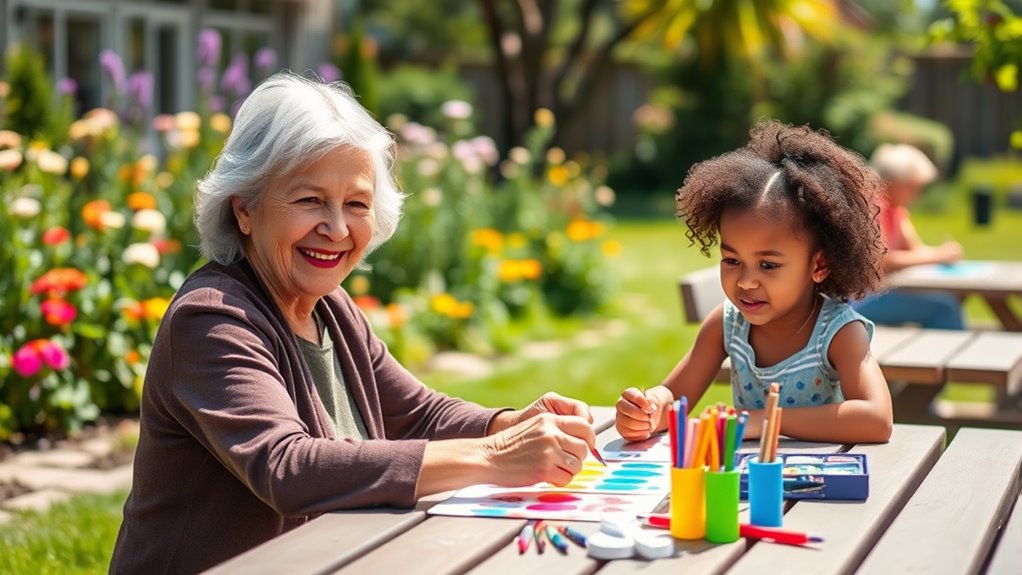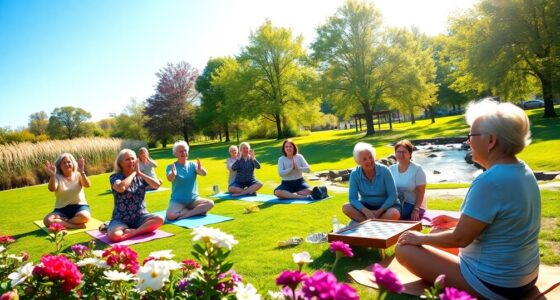Innovative programs like Grandfriends pair seniors with youth to boost mental health for both generations. By fostering meaningful relationships, these initiatives reduce loneliness and create a sense of purpose for seniors, while providing mentorship and connection for younger people. Participating in or supporting such programs encourages community bonding and promotes mental resilience across all ages. If you want to discover how these programs can transform communities, there’s more to explore below.
Key Takeaways
- Grandfriends programs pair seniors with youth to foster meaningful relationships and promote mutual understanding.
- These initiatives reduce loneliness in seniors and provide mentorship and social engagement for young people.
- Activities like storytelling and shared hobbies enhance emotional well-being for both age groups.
- Intergenerational programs strengthen community cohesion and support mental resilience across generations.
- Supporting such programs promotes inclusivity, reduces mental health stigma, and builds supportive social networks.

Mental health is an essential aspect of overall well-being for both seniors and youth, yet many programs often overlook the unique needs of these age groups. One innovative approach gaining traction is pairing seniors with youth through intergenerational bonding programs. These initiatives not only foster meaningful relationships but also strengthen community engagement. When you participate in or support such programs, you help break down age-related stereotypes and create a more inclusive environment where both age groups find purpose and connection.
Intergenerational bonding offers a powerful way to improve mental health by reducing loneliness and isolation, common issues faced by seniors and young people alike. For seniors, engaging with youth provides a sense of relevance and energy, reminding them that they still have valuable insights and experiences to share. For youth, building relationships with seniors offers mentorship, guidance, and a connection to history and tradition. This mutual exchange creates a sense of belonging that’s essential for mental resilience. When you’re involved in these programs, you actively contribute to a community that values the well-being of all its members, fostering empathy and understanding across generations.
Intergenerational bonds foster belonging, empathy, and mental resilience by connecting seniors and youth through meaningful relationships.
Community engagement is at the heart of these initiatives. By bringing different age groups together, you help create spaces where conversations flow naturally and relationships develop organically. This engagement isn’t just about socializing; it’s about building trust and a support network that can help individuals navigate life’s challenges. When you support or participate in intergenerational programs like Grandfriends, you’re helping establish a culture where mental health is prioritized through connection. Such programs often include activities like storytelling, shared hobbies, or volunteering, all designed to nurture these bonds and promote emotional well-being. Additionally, incorporating social activities that encourage interaction can further enhance these positive effects.
These programs also serve broader community interests. They can reduce burdens on mental health services by providing preventive support through social interaction. As you see seniors and youth working together, you’ll notice how their mutual engagement enhances community cohesion and resilience. These interactions reinforce the idea that mental health isn’t just an individual concern but a collective one. When you advocate for or volunteer in intergenerational programs, you’re actively fostering a community environment where mental health resources are complemented by genuine human connection.
Frequently Asked Questions
How Do Grandfriends Programs Impact Mental Health Long-Term?
You might wonder how programs pairing seniors with youth impact long-term mental health. These initiatives promote longevity benefits by encouraging meaningful connections that reduce feelings of loneliness. They also boost emotional resilience, helping you better cope with life’s challenges. Over time, such programs foster a sense of purpose and belonging, which can lead to sustained mental well-being and a more positive outlook in both seniors and youth alike.
Are There Specific Activities Designed for Different Age Groups?
You’ll find that programs focus on age-specific activities to foster intergenerational bonding. These activities are tailored to suit different age groups, ensuring engagement and enjoyment for everyone involved. For young children, activities might include storytelling or arts and crafts, while older adults might participate in gardening or memory-sharing exercises. This approach helps strengthen connections, promotes understanding, and creates a meaningful experience that benefits all ages.
How Are Volunteers Selected and Trained for These Programs?
Did you know that over 80% of volunteers feel more connected to their communities? When selecting volunteers, organizations use thorough volunteer screening to make certain of safety and compatibility. Training programs are essential; they equip volunteers with skills and knowledge about age-related needs and effective communication. You’ll find that these steps help create meaningful, positive relationships, fostering trust and understanding between seniors and youth.
What Are Common Challenges Faced During Program Implementation?
During program implementation, you often face challenges like funding hurdles, which can limit resources and growth. Participant engagement is another common issue, as maintaining interest and active involvement from seniors and youth requires ongoing effort. You need to adapt your strategies to keep everyone motivated and connected, overcoming these obstacles to assure the program’s success. Staying flexible and seeking diverse funding sources helps you navigate these hurdles effectively.
How Can Communities Initiate Similar Grandfriends Initiatives?
To initiate similar grandfriends programs, you should focus on fostering intergenerational bonding and boosting community engagement. Start by reaching out to local seniors and schools, creating partnerships with organizations that support seniors and youth. Organize events that encourage interaction and shared activities, and promote the program through community centers and social media. This approach helps build meaningful connections, strengthens community ties, and supports the well-being of both seniors and youth.
Conclusion
By connecting seniors and youth through programs like GrandFriends, you create a bridge of understanding that benefits both generations. These interactions boost mental health, foster empathy, and build lasting bonds—proof that even in the age of dial-up, human connection remains timeless. So, don’t wait for a knight in shining armor; embrace the chance to make a difference today. After all, in this digital age, real relationships are your greatest treasure.









